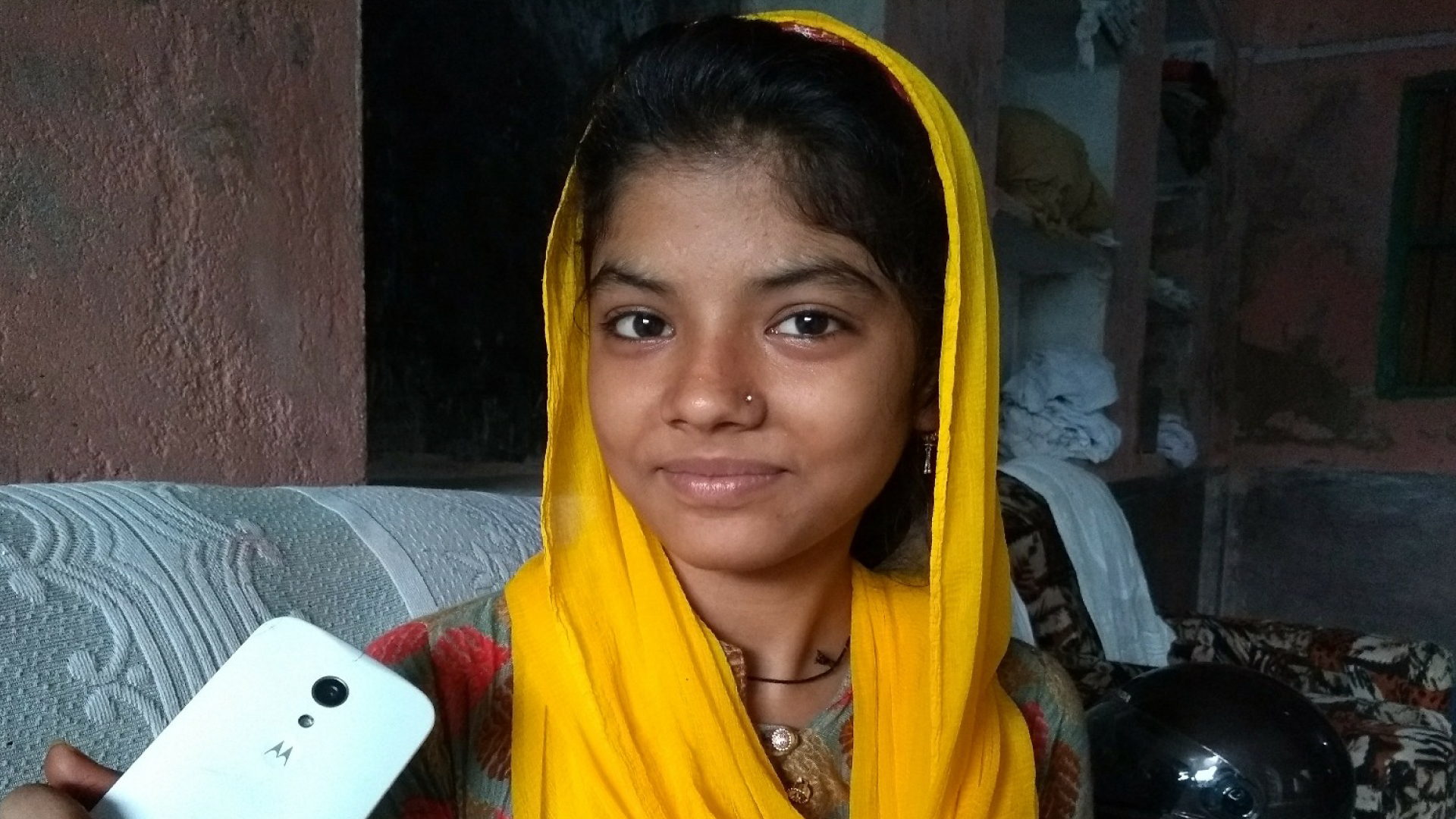
What do we really know about girls and mobile phones?

The untold story of girls and mobile
Mobile phones have the potential to transform the lives of millions around the world, but girls are being left behind. Mobile and internet access is growing rapidly but not equally.
Across low and middle income countries 184 million fewer women own a mobile than men. The gap is bigger when it comes to mobile internet, with women 26% less likely to use it than men (source: GSMA).
Girl Effect and Vodafone Foundation have carried out the first comprehensive global study into adolescent girls and mobile technology. The research gives a voice to the girls accessing, or trying to access, mobile phones and draws on the experiences of more than 3,000 girls and boys from 25 countries.
Scroll down to read the key findings and recommendations from the research and download the executive summary and full report.

1. Girls have more access than we might think
In many of the countries we surveyed, boys are one and a half times more likely to own a phone than girls.
Ownership levels may vary – with just 15% of girls in our sample in Malawi owning a phone, compared to 99% in the USA – but girls are getting hold of phones regardless. Many borrow one from their parents, siblings or friends, even if they already own a phone. Staying in touch with family is one of the most common arguments girls use to persuade their parents to lend them their phone.
Some girls are given a phone by boys or men, or even start a relationship to get one. Those girls who do own a phone are more likely to have a smartphone than a basic phone. Young people report phone ownership is not permanent. Phones break, they can be sold when money is tight, confiscated or used by other family members, or stolen.
Boys are 1.5x more likely to own a mobile phone than girls
Based on sample of 1210 respondents in 6 countries

2. Girls’ use varies broadly
Overall, boys use far more phone features and capabilities than girls. Girls do use phones for a range of activities, but this varies from country to country and depends on level of access.
Without regular access girls can’t develop tech literacy by familiarising themselves with the phone and exploring its uses. Irregular access stops girls learning incrementally. Girls often don’t have anybody who can help them explore the phone and show them new features, especially if they are using it in secret. This can put girls more at risk.
Where girls have more freedom and agency, they are more likely to have better access to phones, and to reap more of the benefits. They report being able to connect with new people, use phones to help their studies, and learn new things. Their tech literacy is higher and they are better able to manage the risks.
In these circumstances, phones are a gateway to new opportunities

3. Many challenges stand in her path
Cost and infrastructure stand between all young people and phone access to some extent. However girls are more likely than boys to encounter social barriers.
While nearly half of girls say they don’t own phones because their parents are worried about their safety, the ability of a phone to keep a girl safe - by ensuring she can contact her family - is also the main reason parents do allow or provide phones.
Wider social norms limit girls’ access and use of phones. Girls can internalise these negative perceptions, with several saying phones could lead them astray. Girls who have more freedom and agency, and more access, are more positive about the benefits of a phone.
Phones can replicate or even exacerbate everyday risks that girls already experience, as well as introduce new ones. For example, phones allow girls and boys to communicate and this can help create relationships, but also put girls at risk of unwanted attention.
52% of girls have to borrow a mobile phone if they want access compared to 28% of boys
Based on sample of 1210 respondents in 6 countries

A girl's story
Irene, 15, Temeke, Tanzania
Irene doesn’t own a phone but borrows one from her friend Grace a few times a week. She mainly uses it to call her boyfriend, but also her friends and relatives who live outside her city.
She says using the phone makes her ‘feel safe and free. If I don’t use a mobile I feel lonely. For example when I miss my boyfriend and I don’t have a mobile phone, I’m always down.’
Irene’s parents refuse to buy her a phone because they are worried it will compromise her safety. They say girls do not ‘understand themselves’ and can’t look after themselves the way boys can. Their biggest concern is that if Irene had a phone, this may lead her to boys and men, and then to sex. They don’t know she uses Grace’s phone to contact her boyfriend.
Irene herself says girls can be ‘silly’ when they get a phone, and thinks girls should use them responsibly.
Her 16-year-old brother Emmanuel has a basic phone he bought himself after saving up money earned working on a local building site. His parents don’t keep tabs on his whereabouts like they do Irene’s, so he’s free to use the phone as he likes.
Irene says if she could have her own phone, she’d use it to chat to friends, family and her boyfriend, and to watch movies and videos. She would also like to use it to help her with schoolwork although she’s not that clear on how a phone can do this.

Where do we go from here?

1. Forget all your assumptions about girls: access is changing and we need to keep up
Instead of limiting discussions to ownership, we need to ask when and how girls gain access to mobiles. We also need to recognise that access to phones is often fluid, and related to complicated socio-economic factors. Further exploration is needed of the direction and causality of findings related to access, to better understand the relationships between girls’ use of phones, and their environment.
2. Address physical and social barriers in order to improve girls’ access to mobile
Mobile phones don’t exist in isolation from the societies in which they are used. The wide range of social and physical barriers to mobile that girls often experience need to be tackled holistically through digital and non-digital means. Mobile phones can and should complement existing development agendas, rather than be a separate CSR initiative.
3. Rewrite literacy for the digital age
Tech literacy is a crucial component of all education and girls risk falling behind if we don’t support this. Support should include integrating tech literacy and digital safety into lessons at school for all students, as well as encouraging broader acceptance of mobile phones among families and communities.
4. Design for online safety
Girls want safer online experiences. When designing platforms special considerations should be made for users who borrow phones. We need to design an experience that is just as safe for a girl who has intermittent access to different phones, as one who has a phone of her own.
5. Design mobile platforms from the users’ perspective
People tend to use phones for what they find most interesting, engaging and important to them personally. From a girl’s perspective the phone is a valuable tool for communication, entertainment and sometimes information, but not necessarily for specific learning outcomes or behaviour change. We need to meet the user where she is, at her level and type of phone use. For example if she only uses her phone to play games, think about how to gamify the experience for her.
6. Involve men and boys
Men and boys often have more access to phones than girls and women, and can act as gatekeepers to access. We need to support gatekeepers to challenge stigma and taboos around mobile phones and show how they can improve girls’ lives in practical ways.
7. Support girls to expand their own digital horizons, as the possibilities for co-creation are infinite!
Girls are better placed than anybody else to design relevant and valuable solutions for their own lives. This presents a huge opportunity for the tech sector to bring the girl into the development process. We need to increase girls’ tech literacy, from daily use of phones to coding ideas and interventions, and enable access to spark creativity and create without boundaries.
8. One size doesn’t fit all
Even in communities where some girls have smartphone access, others will be borrowing basic phones for basic functions. Design with the diversity of audience in mind, for example by using SMS and less-advanced solutions for some situations, and social and online sites for others. Access and use changes constantly so mobile platforms need to be constantly re-evaluated.

Methodology
The study used a unique methodology designed by experts in gender and technology, and advised by MIT D-Lab. This included a detailed literature review; interviews with experts across technology, gender, and international development; a global online survey; and more than 1,000 detailed in-person interviews, across seven countries, led by Girl Effect’s Tech-Enabled Girl Ambassadors (TEGAs). For more information, contact: info@girleffect.org

Get the full report
To read the in-depth research findings and more case studies from girls, download the executive summary and full report below.

Partners
Girl Effect is a creative non-profit that uses media and mobile technology to empower girls to change their lives. Founded by the Nike Foundation in 2004, Girl Effect is active in 66 countries and has reached more than 48 million people through youth brands and mobile platforms that millions of young people love and interact with. Our work helps girls to express themselves, value themselves, and build the relationships they need. Girl Effect is a UK Registered Charity (1141155).
Vodafone Foundation is ‘Connecting for Good’, combining Vodafone’s charitable giving and technology to make a difference in the world. Globally, the Vodafone Foundation (UK registered charity number 1089625) supports projects that are focused on delivering public benefit through the application of technology across the areas of health, education and disaster relief. The Vodafone Foundation invests in the communities in which Vodafone operates and is at the centre of a network of global and local social investment programmes. The Vodafone Foundation has impacted the lives of over 800,000 women and girls through multiple programmes including: life-saving emergency transport for pregnant women; support and surgery to women with obstetric; community health care to pregnant and postpartum women; and access to testing and treatment for HIV+ mothers and children.
Methodological guidance and advising have been provided by MIT D-Lab Research Scientist, Elizabeth Hoffecker, who is a co-founder of the Lean Research approach and an expert in mixed-methods data collection and analysis.























